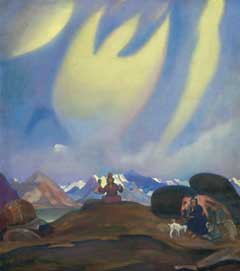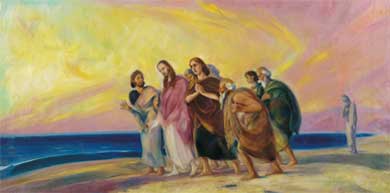| printer friendly | |||
|
|||
 | |
| S. Roerich. Two Рeaks. Gepang. 1934 |
This is how Svetoslav Roerich describes his first meeting with the beauty of the Himalayas, the peaks of which he saw at sun-rise:
“<…> I felt inexpressibly happy. There are no words to describe the feeling of rapture and happiness at the sight of golden masses soaring up into the sky like a symbol of our striving for the Infinity, lit with the light of divine radiance. Such minutes of life are similar to wonderful stars shining on the firmament of our being. Each one is beautiful, each one is unique and inimitable”14.
Amazing luminosity of colors – this is one of Svetoslav Roerich’s painting peculiarities. “Pearly-blue mountains” glitter with a soft light; “Glacial mountains” shine, breathe with all shades of the most delicate, most joyous colors. The colors of the painting “Gepang” are bright and contrasting, but the softening airy haze renders charming mysterious liveliness to the whole landscape.
 | |
| S. Roerich. Saga about Gessar Khan. 1937 |
It is the thought of India, the beauty and subtlety of this country that became the source of artistic inspiration for Svetoslav Roerich’s creation of many philosophic canvases. The inner impulses of the artist’s soul secret depths were reflected in his pieces, so bright and unusual. Svetoslav Roerich said: “At exhibitions, they often ask how true to nature are the colors of my paintings. They even advise: tone down the color, such intensity does not exist in reality… What can I say to this? Those who have not been to the mountains said about my father’s paintings: why do you depart from truth? There cannot be such sky, such huge starts… Those who know the mountains, know these stars, this sky which is as if itself radiating gold or green from inside… The palette of the nature of India, the life of India is dazzling: red earth, blue sky, bright clothes, jewelry of people. Our women for a few minutes create most complicated patterns in their houses, on the floor, and simply on the ground. They take handfuls of crushed stones-quartzites, light or colored, and they pour between their fingers. They move their hands around them, and a most complicated ornament is left on the ground, like a carpet <…> I asked one mistress to put this pattern down on paper; she tried, she was drawing it, but how difficult it was for her! And this everyday carpet which is erased by the evening is created happily, easily, the girls work imitating their mother, like a bird learns singing <…> This is that spirit <…> – in everything. <…> These elements of reality can make paintings which they traditionally call allegoric”15.
Like philosophic parables, Svetoslav Roerich’s paintings about the life of the Indian village are perceived. And at that, they are all very convincing. It seems you are yourself where a peasant follows a heavy plough, whipping up the buffaloes on the red earth of South India (painting “Ploughing”). The sun light fills the whole space of the painting. The chain of distant mountains is shrouded in pinkish-pearly clouds. The same clouds outline the figures of the ploughman and the buffaloes, uniting the working man and the nature in a single harmonious whole. The painter does not admit the banality of what is happening, but paints the mystery of Eternity, where “ <…> all is merged together: labor of man, nature, mountains, “biosphere” passing into cosmos”16.
 | |
| S. Roerich. Christ with His disciples. Late 1930s – early 1940s. |
“The mission of an artist is to carry beauty to our life, Svetoslav Roerich wrote, – to reveal it for the others, to attract to it our attention and show something more than our everyday life routine, – life of tomorrow, life of a greater world, development of the next stage of our life evolution. Thus, an artist must be also a prophet, tuned to the sound of ever-existing powers, capable of reading and penetrating into evolutionary currents”17.
The Kingdom of Spirit, free from the chains of physical limitation, arises on Svetoslav Roerich’s canvases of the last period of his creative work. Ludmila Shaposhnikova – the N. Roerich Center-Museum General Director – tells about those wonderful paintings, her acquaintance with them. In 1922, Ludmila Shaposhnikova went one day to the painter’s studio located in his estate Tataguni (at that time, Svetoslav Roerich lived already in Bangalore). “I opened the door of Svetoslav Roerich’s studio, and we entered the so familiar to me room. On the floor, leaned against book-shelves and covered with polyethylene, the studio owner’s paintings were standing. Many of them I knew from exhibitions, reproductions, and personal communication with the author in this very studio. This was Beauty created by a big artist. But now, removed from the polyethylene package, paintings that I had not seen before started changing each other before me. Bright, luminous colors, strange, as if earthly, and at the same time unearthly shapes. A delicate and beautiful woman’s face appearing from some whimsical images, a village which at the same time was not a village, a river going through the mountains and lighting them from inside. Even now I find it difficult to give a clear description of what I saw. But at that time, I understood that Svetoslav Roerich depicted, in the two-dimensional space of canvas, the subtle world of the fourth, or, maybe, even higher dimension. He saw and foresaw that world with his subtle centers, his high energetics. Having at his disposal the language of the two-dimensional space, he managed with its help to maximally approach another world, to open as if a window into it, and to prove the unlimited possibilities of art. His canvases carried to people the unique experience of the master himself and told about the reality and accessibility of strange distant worlds. The paintings confirmed that man himself, carrying in himself the worlds of higher dimensions, is as a bridge between them and the solid world”18.
Those were the paintings of that last cycle of the painter’s creative work which is not familiar even to admirers of his painting. Unfortunately, they were stolen after Svetoslav Roerich’s death, and presently we do not know their location.
 | |
| S. Roerich is talking with visitors of his exhibition
at the State Hermitage. Leningrad. January 1975 |
The whole family of the Roerichs was a single spiritual phenomenon. “Our family’s life was life in labor, the younger son wrote. – All of us, each in his own field, worked, but all always worked together. The four of us made a single whole and helped each other. This allowed us to know very much, to collect and give to the others”20. They all loved Russia, knew it deeply and understood its culture, were convinced of this country’s high mission and believed in its future.
Together with his wife, beautiful Indian woman Devika Rani, R. Tagor’s grandniece, Svetoslav Roerich not once came to his Motherland with exhibitions of paintings, his own and his father’s. After the death of his brother Yuri in 1960, Svetoslav remained the only custodian of his family unique heritage. Executing their parents’ behest related to the heritage transfer to the mother country, S. Roerich became the founder of our N. Roerich Center-Museum in Moscow.
In conclusion we would like to quote Svetoslav Roerich’s words said by him in one of the interviews: “We want to make a happier life. Is it so? What is that happier life? We see that, undoubtedly, we must remember about spiritual elements… Unfortunately, we forget from where we have come out, where we are going, what we are. We forget that we have come out of eternity. Eternity is around us… Out of Infinity and Eternity. They are laid in each of us. We are carrying them, these are great sensations. Unfortunately, we very often forget about it. Now – how to do it (to make a happier life)? Everything is simple, extremely simple! Only we must remember every day that today we want to do something better than we did yesterday. So that it be at least a little bit better. This wish to move forward – this is everything!.. That is why I am saying that everything is very simple…”21.
|
|
||
|
||
